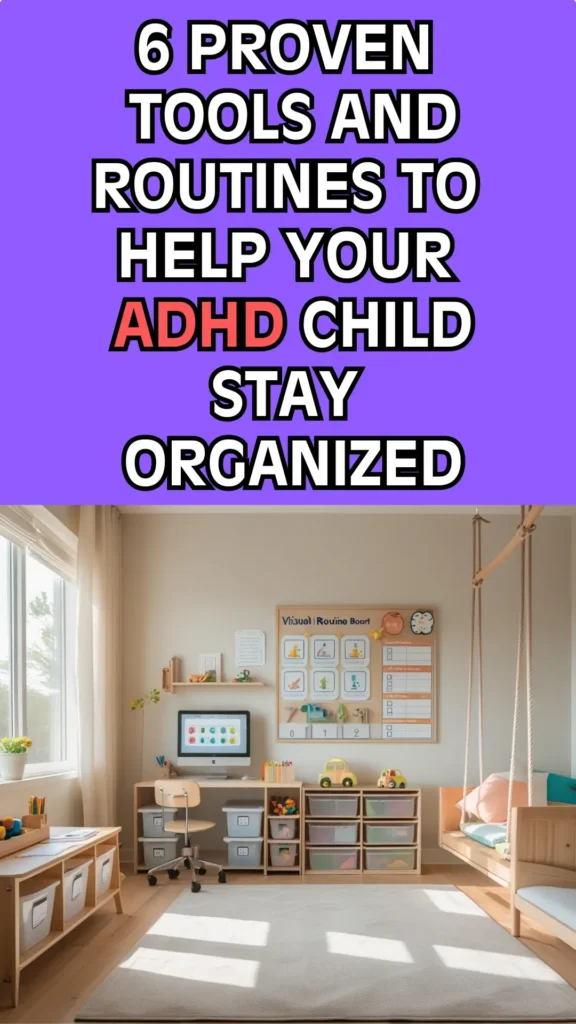Why Everything Feels Like Too Much Sometimes
If you’re parenting a child with ADHD, you know how quickly things can spiral.
Shoes in the fridge. Glitter in the dog bowl. Forgotten homework halfway to school.
It’s not that your child doesn’t care. Their brain just processes the world differently. And typical organizing systems? They usually don’t stick.
This post is for moms who want to help their ADHD kids build structure without turning every day into a battle. And hey, even if you also have ADHD (diagnosed or not), the tips in here will help you, too.
Because we all deserve systems that make life easier, not harder.
Don’t forget to save this pin for later! You’ll want to come back to these tried-and-true strategies.

Let’s dive into a handful of tools and routines that don’t just sound good in theory. They actually work.
1. Visual Schedules (So You Don’t Have to Say It 25 Times)
Transitions are tough for ADHD kids.
Brushing teeth, getting dressed, leaving the house. Instead of barking reminders on repeat, use a visual schedule with pictures or icons that show what comes next.
Stick it on the wall, the fridge, or near their bed. Make it part of the routine.
The predictability helps them feel secure. And it saves you from playing drill sergeant before 8 a.m.
Bonus: You can use a dry-erase version and let them check things off. Extra dopamine hit!
2. Clear Storage Bins (Because Out of Sight = Gone Forever)
If they can’t see it, it basically doesn’t exist. That’s why clear bins are gold for ADHD brains.
Use them for toys, art supplies, socks. Anything really.
Label them with words and pictures so your child can put things away without needing to remember a “system.” Keep the bins low and accessible so they can actually use them.
Forget fancy. Think visible, reachable, and simple.
3. The Weekly Reset Basket (AKA: Contain the Chaos)
No matter how organized you are, stuff piles up. That’s just reality.
So instead of battling clutter daily, do a weekly reset.
Have a basket (or two) for each kid. Once a week, do a quick sweep of the random toys, books, socks, gum wrappers. Whatever. And toss them in.
Then sort together.
It becomes a ritual: low-stress, predictable, and oddly satisfying. And it teaches your child to participate in cleanup without melting down.
4. Color Coding Everything (Give Their Brain a Shortcut)
ADHD brains crave fast, intuitive cues. Color coding is a simple, powerful way to make their world easier to navigate.
Use colors for folders, bins, clothes drawers, water bottles, even chore charts. You can assign one color per kid or by type of item (school = blue, sports = red).
No explanations needed. Their brain just gets it faster. And yours will thank you too.
5. Visual Timers (So Time Stops Being an Abstract Concept)
“Five more minutes!” means nothing if your child has zero sense of time.
Visual timers help them see how time is passing. Whether it’s for getting dressed, finishing homework, or brushing teeth.
Use sand timers, countdown clocks, or even apps with visual cues.
Instead of arguing, let the timer be the bad guy. It turns nagging into a challenge: “Let’s see how much you can tidy before the timer runs out!”
6. Anchor New Habits to Existing Routines
Don’t try to build a whole new schedule from scratch. Link new tasks to habits that already happen.
For example:
- After breakfast = pack backpack
- After brushing teeth = check chore chart
- After screen time = put toys away
It’s called habit stacking, and it makes routines feel automatic. Not forced.
This works beautifully for ADHD kids because it reduces mental load and builds consistency without power struggles.
One More Thing: If You Also Have ADHD…
You are not a bad mom for struggling with structure. ADHD makes it harder. Not impossible.
And every single one of these tools? They’ll support your brain too.
So even if your kid has ADHD and you’re barely holding it together yourself, these ideas can help both of you. Not perfectly. But better.
Final Thoughts: You’re Not Failing (This Is Just Hard)
Helping an ADHD child stay organized isn’t about making them conform to a rigid system. It’s about finding tools that meet their brain where it’s at. With compassion, not control.
You don’t have to overhaul your whole house. Just pick one tip and try it this week. See what sticks. Then build slowly.
This isn’t about perfection. It’s about creating a home where your child (and you) can breathe a little easier.
You’re doing better than you think. And you’re not alone.